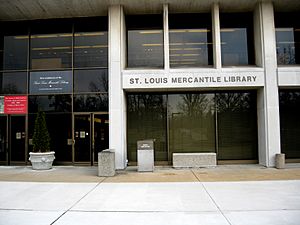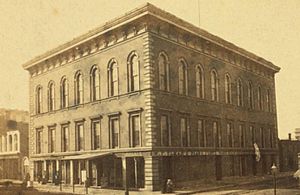St. Louis Mercantile Library facts for kids
Quick facts for kids St. Louis Mercantile Library |
|
|---|---|
 |
|
| The library's current home on the campus of the University of Missouri-St. Louis. | |
| Country | United States of America |
| Type | Special collections |
| Scope | Americana |
| Established | 1846 |
| Branch of | Thomas Jefferson Library |
| Collection | |
| Items collected |
|
| Size | Over 250,000 books and 400 archival collections |
| Other information | |
| Director | John N. Hoover |
| Website | http://www.umsl.edu/mercantile/ |
| Phone number | 314-516-7240 |
The St. Louis Mercantile Library is a historic library in St. Louis, Missouri. Founded in 1846, it is the oldest library west of the Mississippi River. It started as a membership library, where people paid a fee to join and borrow books. Today, it is part of the University of Missouri-St. Louis and holds many rare and special collections.
The library's amazing collections have made it a City Landmark of St. Louis, Mo.. Its main collections focus on four areas: a general collection, the history of railroads, the history of America's rivers and waterways, and an art museum.
Contents
The Library's Long History
How the Library Began
In 1845, a group of city leaders and philanthropists (people who donate money to good causes) decided to create a library. They wanted a positive place for young people to spend their evenings. The library officially opened in 1846 and was an instant success.
At the time, free public libraries were not common. The Mercantile Library became a center for culture and learning in St. Louis. It had reading rooms, meeting spaces, and the largest auditorium in the city. The first president was James E. Yeatman, who also helped start Washington University in St. Louis.
Famous speakers like Mark Twain, Ralph Waldo Emerson, and Oscar Wilde gave lectures at the library. The St. Louis Symphony even held its first concerts there.
New Buildings and Big Moments
In 1854, the library moved into a grand new building. This building had a 2,000-seat auditorium called the Grand Hall. This hall was so important that it hosted major historical events.
During the American Civil War, a meeting was held there in 1861 where Missouri leaders voted to stay in the Union. In 1865, another meeting in the library officially ended slavery in Missouri.
By the 1880s, the library needed a new, fireproof building. The old one was torn down, and a new six-story building was built in the same spot in 1889. This modern building had an elevator and, by 1901, used electricity instead of candles. The library even had a book delivery service using a Ford Model T car!
Building a Special Collection
When the free St. Louis Public Library opened in 1893, the Mercantile Library changed its focus. It began to concentrate on its amazing historic collections of books, papers, and art.
The library has collected American art since it first opened. It also gathered materials about the history of St. Louis and its industries. In 1983, it created a special collection all about railroads. This collection was named for John W. Barriger III, a railroad executive who donated his huge personal library. In 1985, a collection about America's rivers and boats was added.
The library is also home to the old photo and article files from the St. Louis Globe-Democrat newspaper, which started in 1854.
The Library in Modern Times
In the 1990s, the library's leaders decided to move to make its collections easier for people to access. In 1998, the library moved to its current home at the University of Missouri-St. Louis. It is now a special collections library inside the university's Thomas Jefferson Library.
While it is still a membership library, most of its collections are open to the public for research. Members get extra benefits like special borrowing rights and invitations to private events.
A lot of the library's collection is on display in an "open-storage" style. This means visitors can see a large part of the collection at any time. The library also hosts free art and history exhibits.
Amazing Treasures in the Collection
The library holds many unique and priceless items.
- Railroad History: The John W. Barriger III National Railroad Library has over 45,000 items about railroads, including photos and company records.
- River History: The Herman T. Pott National Inland Waterways Library contains documents, art, and objects related to river travel.
- Newspaper Archives: It has over 10 million photos and clippings from the St. Louis Globe-Democrat and official copies of the St. Louis Post-Dispatch.
- Aviation History: The library holds photo and film archives from Trans World Airlines (TWA).
- Famous Art and Books:
- A complete first edition of John James Audubon's famous book, Birds of America.
- The actual journal of Auguste Chouteau, one of the founders of St. Louis.
- A beautiful marble sculpture called Beatrice Cenci by Harriet Hosmer.
- Four portraits of Winnebago chiefs painted by artist Charles Deas.
- A plaster death mask of Napoleon Bonaparte.



